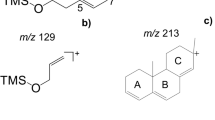Abstract
A common detector for the analysis of sterols and sterol concentrates by gas chromatography is the flame ionization detector (FID). The detector measures the response of ions from a molecule as it is pyrolyzed in a hydrogen flame. The response is relative to the number of hydrogen and carbon atoms in a molecule and it gives different responses for the same amounts of different analytes. Theoretical correction factors (TCF) can be used to account for these differences during data analysis and are based upon the number of active carbons in a molecule and can be calculated from known structures. TCF have been used to provide a more reproducible approach to the analysis of sterol concentrates in raw materials. Use of empirical correction factors (ECF) requires determination of relative responses for each analyte and also a high purity standard (and determination of that purity), which can be expensive or difficult to obtain for the more uncommon sterols. Experiments have been conducted to determine ECF for Ergost-5-en-3-ol, (3β,24R), commonly known as campesterol, Stigmasta-5,22-dien-3-ol, (3β,22E), commonly known as stigmasterol, and Stigmast-5-en-3-ol, (3β), commonly known as β-sitosterol and compared to the calculated TCF for these same sterols. The experiments evaluated differences in concentration, standard purity, and injection technique and found that all three factors had an effect on the determination of ECF. It was also found that cool on column injections gave more accurate ECF values and are preferable for quantitative analysis of sterols.
Similar content being viewed by others
References
McWilliam IG, Dewar RA, Desty DH (1958) Gas Chromatography. Butterworths, London, pp 142–152
Ettre LS, Kabot FJ (1963) Relative response of fatty acid methyl esters on the flame ionization detector. J Chromatogr II 114–116
Ackman RG, Sipos JC (1964) Application of specific response factors in the gas chromatographic analysis of methyl esters of fatty acids with flame ionization detectors. J Am Oil Chem Soc 41:377–378
Bannon CD, Craske JD, Hilliker AE (1986) Analysis of fatty acid methyl esters with high accuracy and reliability. V. Validation of theoretical relative response factors of unsaturated esters in the flame ionization detector. J Am Oil Chem Soc 63:105–110
AOCS Method Ce 1 h–05 (2005) Determination of cis-, trans-, saturated, monounsaturated and polyunsaturated fatty acids in vegetable or non-ruminant animal oils and fats by capillary GLC
Code of Federal Regulations (2007) Title 21, vol 2, 21CFR101.83
AOCS Method Ch 6–91 (1997) Determination of the composition of the sterol fraction of animal and vegetable oils and fats
Craske JD, Bannon CD (1987) Gas liquid chromatography analysis of the fatty acid composition of fats and oils: a total system for high accuracy. J Am Oil Chem Soc 64:1413–1417
Bannon CD, Craske JD, Felder DL, Garland IJ, Norman LM (1987) Analysis of fatty acid methyl esters with high accuracy and reliability. VI. Rapid analysis by split injection capillary gas-liquid chromatography. J Chromatogr 407:231–241
Hindriks FR, Wolthers BG, Groen A (1977) The determination of total cholesterol in serum by gas–liquid chromatography compared with two other methods. Clin Chem Acta 74:207–215
Frega N, Bocci F, Giovannoni G, Lercker G (1993) High resolution GC of unsaponifiable matter and sterol fraction in vegetable oils. Chromatographia 36:215–217
Aizetmuller K, Bruhl L, Fiebig HJ (1998) Analysis of sterol content and composition in fats and oils by capillary-gas liquid chromatography using an internal standard. comments on the German sterol method. Fett/Lipid 100(9):429–435
McLafferty FW, Turecek F (1993) Interpretation of mass spectra, 4th edn. University Science Books, Sausalito
Acknowledgments
The authors would like to thank Mitchell Altschuler, Michael Kluetz, and Matt Smith of Cargill Health and Nutrition for approving publication of this manuscript. We would like to thank Gregg Perri of Cargill Global Food Research for help with proofreading and editing. We also thank Cory Nelson of Cargill Information Services for providing chemical abstract names and numbers and Sean Smith of Cargill Global Food Research Advanced Analytics for help with the statistical analysis.
Author information
Authors and Affiliations
Corresponding author
About this article
Cite this article
Costin, C.D., Hansen, S.L. & Chambers, D.P. Using Theoretical Correction Factors for Quantitative Analysis of Sterols and Sterol Concentrates. J Am Oil Chem Soc 86, 111–118 (2009). https://doi.org/10.1007/s11746-008-1332-9
Received:
Revised:
Accepted:
Published:
Issue Date:
DOI: https://doi.org/10.1007/s11746-008-1332-9




